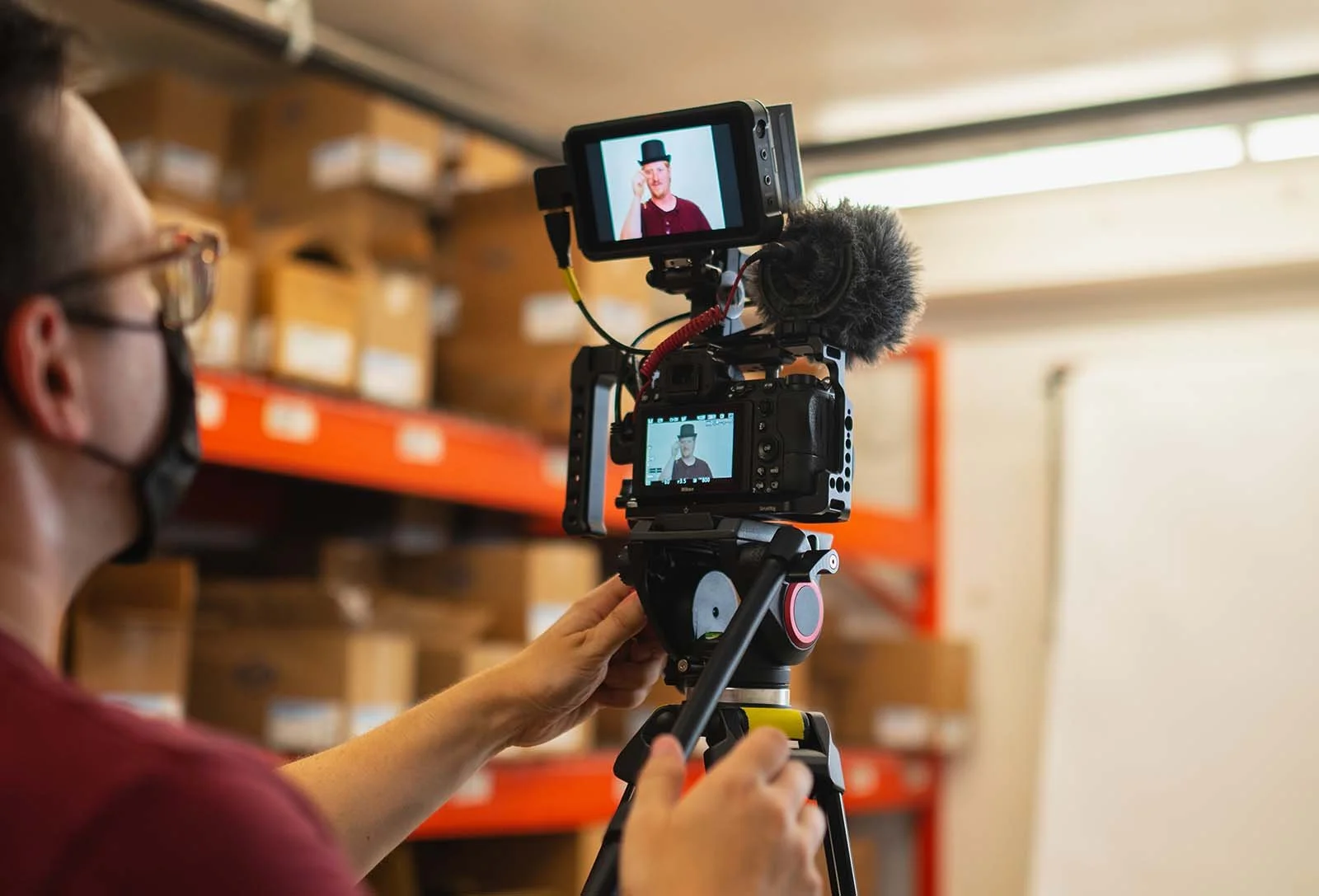More Tips for Directing People on Camera
If you read part 1 of this blog (How to Direct People on Camera), you’ve hopefully picked up a bunch of tips on how to coax a good video performance out of almost anyone.
Today, I’m returning to expand on this topic of conversation with a few more important things that I didn’t get around to highlighting the first time. Some of these are things I’ve been reminded of recently, and some might’ve been cut for sake of length. Either way—we’re here today, and that’s all that matters!
Once more, this is not a be-all-end-all list of tips and tricks on how to direct people on camera. That’s an infinite task you could dedicate your life to doing and still not emerge with a 100% batting average. Nonetheless, here’s what I’ve picked up so that you can hopefully save a little time.
1. The “One more for safety” trick
I’m leading off this article with what I consider to be the most important thing you should know (backwards from the clickbait philosophy of writing) and one that happens at the end of a given take when actually filming. All of that to say: it’s a little backwards to be opening here, but it’s such a great little thing to do that I don’t want anyone to miss it.
Say you’re filming a particular piece of dialogue that your talent is saying to the camera. It might take you 10 minutes of trials to get one good take that makes everyone on set go “YEAH!” and pump their fists into the air. That’s great.
Tell you talent, “Let’s do one more good take for safety’s sake” and get one more good take.
Why is this a good idea?
Often the “safety” take is the best take—even better than the one you celebrated 5 minutes ago. This ends up being the one you’ll likely use in the edit.
It makes editing way faster, because you can scrub through you footage in reverse-chronological order of takes. You know that you only moved onto the next scene when you were happy with the final take of the last scene (generally speaking). Now, when sifting through footage, start here.
Your talent is already relaxed because you are able to reassure them, “Hey! We’ve already got a take we’re thrilled with. This one is just sort of for redundancy’s sake, so you don’t need to agonize over getting it perfect.” This puts them at ease and gets them to do a much better take before you move on. They relax in ways you can’t even articulate, and (again) you often get the best take of the whole lot there. NOW when you celebrate that great take, they are over the moon and feeling excited about making progress on the video. This is fantastic momentum to carry you through.
It actually does give you a safety if something went wrong the first time. Distracting background element; someone spoke; photobomb; booger hanging out of the nose; missed focus. Whatever. You actually have an alternate version you can use if that one didn’t work out.
2. Say the title of the video
Assuming you’re not shooting a narrative film but are filming a promo or educational video of some kind, it’s helpful to have the talent (naturally) say the title of the video somewhere in their introduction. This is especially useful if you’re going to post it on TikTok or another social media platform later.
It can become confusing to viewers (with short attention spans) to watch a video with a title that is never explicitly mentioned in the introduction. It’s a super subtle thing—and it’s more annoying in some contexts than in others—but I really recommend trying to work the title of the video into the intro for the sake of redundancy (or safety. Ha!).
3. Introduce themselves
This doesn’t apply for every video, but I err on the side of having anyone on camera introduce themselves (or, at the very least, have a title card that flashes on screen that explains their relevance to the video).
Introducing themselves allows a viewer to instantly connect with the video a little more. It bridges the gap between your video and the viewer just that little bit. It shows them that there is a human being on the other side of this piece of marketing material.
You wouldn’t meet someone on the street and entertain their conversation for very long if they didn’t even make a mild effort to be personable. That’s what introducing one’s self on video does: it makes the video feel more human. Even if your talent doesn’t have a particularly prominent role in the organization or may not be the top-dog to be leading this part of the video: there’s almost always an argument to be made about why they should introduce themselves. I highly recommend it.
4. Make sure they know where to look (and where not to)
Ever had a conversation with someone who couldn’t make eye contact with you? If they just kept looking around the room, it would be really distracting and you’d wonder what the heck was going on.
The same phenomenon can happen in video if you’re not careful. If you talent isn’t looking in the right place (whether that’s straight down the barrel of the lens or off camera at an “interviewer” or whatever), it can cause your audience to disengage with the video and become distracted from what it is the talent is actually trying to convey.
Make it abundantly clear where you talent should look prior to the filming commences, and remind them throughout if you have to. Make sure they know where not to look if that’s at a camera operator or the director just off to the side of the camera. You don’t want the quality of your video diminished because the person speaking on camera seems distracted.
5. Minimize distractions
Having unnecessary people in the room can make your job in loosening up your talent that much more difficult. If you’re filming in a space where there might be other people that make your talent self-conscious, do what you can (well ahead of filming, but just before hitting record if you must) to ask them to step outside for a moment, step out of the sightline of the person on camera; whatever.
Sometimes distractions are not people. It might be a line-of-sight distraction like something just behind the camera that causes them to look away. It might be something moving out of the corner of their eye that causes them to instinctually look in that direction.
Whatever it is, try to think ahead about what things might be distracting to the person on camera, and get rid of them as soon as you can.
6. Encourage energy, enthusiasm, facial expressions
There is no faster way to get someone to behave in a bizarre manner than to say, “Act naturally!”. It just makes no sense. Similarly, when you start recording someone and they become acutely and overly aware of each and every thing they’re doing, they might fail to have energy, enthusiasm, and excitement on camera in subliminal ways that pertain to body language.
When appropriate, encourage your talent to use hand gestures, look around once in a while, and just act, feel, talk, move in a way that conveys enthusiasm for the project at-hand.
In the editing room, it is far harder to liven up someone’s un-energetic performance than it is to try to tone down someone’s overly energetic performance (in my personal opinion. Professional editors may disagree—I really have no idea). Of course, editing and music choice can all play a role in how someone comes across, but it’s important that your talent recognizes as a general rule, turn up your personality just a little bit for the camera and it will come across that much better.
7. Plan for more than enough time
Especially when filming someone new on camera that you’ve never shot with before, plan double or maybe even triple the amount of time you think you’ll need to film their part into the schedule. Far better to have the time and not use it than to wish you had it when you desperately need it.
Having excess amounts of time removes the stress and anxiety of “we need to get this take done asap” from the task that is filming. There’s nothing worse than you (as the director) looking at your watch and thinking “holy crap. We’re either going to be way late for the next part or we’re going to have to cut some of this from the script.” That is a terrible place to be.
You will be shocked at all of the ways you can waste time on set on trivial things. Plan for it by including tons and tons of buffer time: especially when the situation is new to one or more of you. It is easy to overestimate your abilities in pre-production.
Last big benefit to doing this: Imagining you don’t use all of the time you’ve allotted, you get to brag (however embellished it may be in your head), “Man! We are way ahead of schedule! Way to go team! Onto the next part!”. Again, this builds confidence and momentum in your talent, and hopefully keeps things progressing nicely. If they ultimately do use all that time, the worst you can say is “We’re right on schedule! Way to go!”. Still a positive. Still builds confidence and momentum.
In Summary
Filming people on video is a delicate balance. You—as the director—have a lot on your mind! This is why Hollywood film sets often have dozens of people fulfilling different roles on set: in order to do one of those jobs really, really well, you are going to want someone dedicated to it solely. Of course, in real life (when this video is just one of many responsibilities you have), it doesn’t work like that. Ain’t nobody got the budget.
You will figure out a lot of this as you go. You might re-read this and see “Wow! Aidan was right!” and that would be awesome.
But more importantly than that: I hope you’ve picked up on something that is going to save your bacon before you’ve made the mistake. That’s the whole point of me writing lol.
Cheers. Make a great video!

